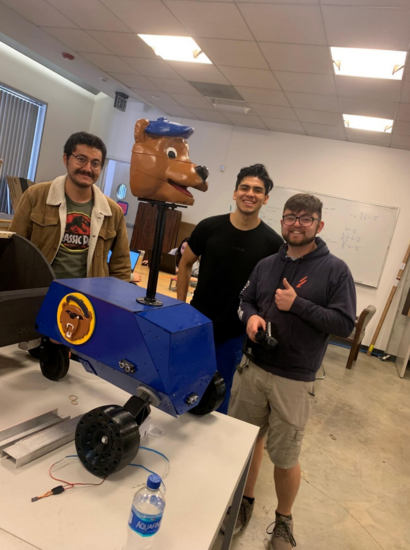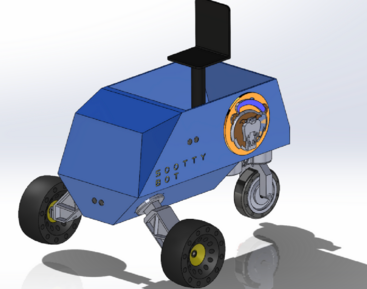
Part mascot. Part machine. All Scotty.
A team of mechanical engineering students recently developed a wheeled, robotic version of our university’s beloved mascot Scotty Highlander. Dubbed “RoboCUB” or “ScottyBOT,” it is capable of navigating on its own, avoiding obstacles, and basic communication. And while this autonomous robot platform may be used for campus tours, announcements, and advertising, it served a greater purpose: preparing them for their future engineering careers.

“ScottyBOT” (designed by Kevin Montufar, Reilly Parker, Jonathan Garcia, and Mario Abarca) is just one example of the dozens of Senior Design projects completed last spring by seniors working in teams from across the Marlan and Rosemary Bourns College of Engineering’s (BCOE) five departments. The projects and accompanying courses are required components of students’ degree program curriculum. They provide students the opportunity to apply the scientific knowledge and technical skills they learned in class to hands-on, real-world industry problems and engineering challenges.
Projects spanned a wide range: an autonomous robot capable of delivering food and packages, the next generation of solar-powered drones, an improved 3D-printing process for manufacturing process, and flight computers and communication systems for satellites small enough to hold in the palm of your hand.
“Senior Design allows students to get involved in real engineering problems spanning from the hands-on state-of-the-art industry-type to cutting-edge leading research projects,” said Farbod Khoshnoud, a mechanical engineering faculty member and a project advisor.
These projects are crucial in providing students the opportunity to sharpen their scientific and technical skills and engage in job-ready experiences such as working productively in teams, written and oral communications, risk analysis, environmental and ethical issues, and occupational health and safety.
Recent chemical engineering graduate Stewart Shining worked on designing a petrochemical process that would be useful for the oil-refining industry.
“For me, personally, it really opened my eyes to how engineers are tasked with applying knowledge to create solutions,” he said. “I underestimated the amount of presentations and preparation that engineers have to do for meetings and propositions, but it makes sense in hindsight that this would be the case since most of the people that we will have to propose to will not be engineers, but investors and senior management at companies or government bodies.”

Senior design projects are highlighted on campus with public displays, poster presentations, and special events, such as department open houses and the Bioengineering and Materials Science Senior Design Showcase held on May 12 and the Mechanical Engineering Senior Design Poster Exhibition on June 5.
“A senior design project enables students to practice knowledge they learned in previous courses, work on real-world engineering projects, and gain valuable project-planning, teamwork, and presentation skills,” said Jiamin Zhang, assistant professor of chemical and environmental engineering.
Such experiences are amplified when industry sponsors or mentors provide support. Examples of sponsors include Howmet Aerospace, a leading manufacturer of aircraft components that has collaborated with Dmytro Zagrebelnyy, assistant teaching professor of materials science and engineering, and Loma Linda University Medical Center, one of the state’s top hospitals that has worked with Rob McKee, assistant teaching professor of bioengineering.
Prospective industry sponsors are encouraged to contact Associate Director of Corporate & Strategic Partnerships Mike Allen at mrallen@engr.ucr.edu.